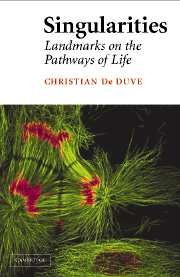Book contents
- Frontmatter
- Contents
- Foreword
- On Christian de Duve: An Editor's Appreciation
- General Introduction
- 1 Building Blocks
- 2 Homochirality
- 3 Protometabolism
- 4 ATP
- 5 Electrons and Protons
- 6 Thioesters
- 7 RNA
- 8 Proteins
- 9 DNA
- 10 Membranes
- 11 Protonmotive Force
- 12 Protometabolism Revisited
- 13 The LUCA
- 14 The First Fork
- 15 Eukaryotes
- 16 Oxygen
- 17 Endosymbionts
- 18 Multicellulars
- 19 Homo
- 20 Evolution
- Final Comments
- Bibliography
- Index
5 - Electrons and Protons
Published online by Cambridge University Press: 18 January 2010
- Frontmatter
- Contents
- Foreword
- On Christian de Duve: An Editor's Appreciation
- General Introduction
- 1 Building Blocks
- 2 Homochirality
- 3 Protometabolism
- 4 ATP
- 5 Electrons and Protons
- 6 Thioesters
- 7 RNA
- 8 Proteins
- 9 DNA
- 10 Membranes
- 11 Protonmotive Force
- 12 Protometabolism Revisited
- 13 The LUCA
- 14 The First Fork
- 15 Eukaryotes
- 16 Oxygen
- 17 Endosymbionts
- 18 Multicellulars
- 19 Homo
- 20 Evolution
- Final Comments
- Bibliography
- Index
Summary
ATP, the subject of the preceding chapter, is often called the “fuel of life.” This is a misnomer. ATP is no more than an intermediary between the provision and the use of energy. What really fuels life is the fall of electrons from a higher to a lower energy level. The mechanisms underlying such energy-yielding electron falls and the associated assembly of ATP represent the heart of bioenergetics. Only their essential lineaments will be outlined in this chapter. More details can be found in standard textbooks and in previous publications (de Duve, 1984, 2001).
Energetics of Electron Transfer
Almost invariably, the assembly of ATP from ADP and inorganic phosphate is coupled to the transfer of one or two electrons between two substances, called the electron donor and acceptor for obvious reasons. In such transfers, the donor passes from the reduced (electron-rich) state to the oxidized (electron-poor) state, while the acceptor passes from the oxidized to the reduced state. In the reverse reaction, the reduced acceptor becomes the donor, and the oxidized donor the acceptor. This explains why such electron transfers are called oxidation–reduction reactions (redox reactions for short), and the substances involved in them are called redox couples because of their ability to exist in both reduced and oxidized form.
It often happens that protons (hydrogen ions, H+) accompany the transferred electrons, so that hydrogen atoms (H=H+ + electron), rather than naked electrons, are transferred (transhydrogenation). Sometimes, hydrogen atoms are donated and only electrons accepted, or vice versa.
- Type
- Chapter
- Information
- SingularitiesLandmarks on the Pathways of Life, pp. 41 - 53Publisher: Cambridge University PressPrint publication year: 2005

